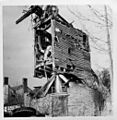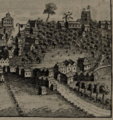List of windmills in Essex facts for kids
Have you ever wondered how people used to grind grain into flour before electricity? For hundreds of years, windmills were super important! They used the power of the wind to turn huge grinding stones. Essex, a county in England, has a long history with these amazing buildings. Many windmills once stood here, helping communities make bread and other foods. Some are still standing today, reminding us of the past. This article will tell you all about the different types of windmills in Essex and some of their interesting stories.
| Top - 0-9 A B C D E F G H I J K L M N O P Q R S T U V W X Y Z |
What are Windmills?
Windmills are machines that use the wind's energy to do work. Most often, this work was grinding grain. They were a vital part of life for centuries. Imagine a time without electric motors or factories. Windmills were the high-tech solution!
How Windmills Work
Windmills have large blades, called sails, that catch the wind. These sails are connected to a central shaft inside the mill. As the wind pushes the sails, the shaft turns. This movement powers gears that turn heavy millstones. The millstones then grind grain into flour. It's a simple but very clever system!
Types of Windmills in Essex
Windmills come in different shapes and sizes, each designed a bit differently. Essex had many kinds, showing how people adapted to the wind and their needs.
Post Mills: The Oldest Type
The post mill is one of the oldest types of windmills. The entire body of the mill, which holds all the machinery, sits on a single, large central post. This means the whole building has to turn to face the wind!
- Turning to the wind: To catch the wind, workers had to push or pull the entire mill around. This was hard work!
- Early history: Many of the earliest windmills in Essex were post mills. Some date back to the 13th and 14th centuries.
- Examples:
- The mill at Aythorpe Roding is a great example of a post mill. It was built around 1779.
- Bragg's Mill in Ashdon, built in 1757, is another historic post mill.
- Duck End Mill (1756) is also a post mill.
- Mountnessing Mill, built in 1807, is a well-known post mill.
- Ramsey Mill (1842) is a later example of a post mill.
Smock Mills: A Sturdier Design
Smock mills look a bit like a person wearing a smock (a loose outer garment). They have a tall, wooden tower with sloping sides.
- Rotating cap: Unlike post mills, only the top part, called the cap, turns to face the wind. This made them easier to operate.
- Stronger base: The fixed base meant they could be taller and hold more machinery.
- Examples:
- Baker Street Mill (1796) is a smock mill.
- Terling Mill (1830) is another smock mill.
- The East Mill in Southminster (1790) was a smock mill.
- The mill at Willingale Doe (1757) was also a smock mill.
Tower Mills: Built to Last
Tower mills are usually made of brick or stone, making them very strong and durable.
- Fixed tower: Like smock mills, only the cap turns to face the wind.
- Long-lasting: Their strong construction meant they could stand for a very long time.
- Examples:
- Clavering has two tower mills, the South Mill (1757) and the North Mill (1811).
- Debden Windmill (1796) is a tower mill.
- Gibraltar Mill (1704) is a very old tower mill.
- Church End Mill (1822) is a tower mill.
- Rayleigh Mill (1809) is a famous tower mill.
- John Webb's Mill (1804) is a beautiful tower mill.
- Messing Maypole Mill (1775) is another example.
- Gainsford End Mill (1869) is a later tower mill.
- White Roding Mill (1877) is a tower mill.
- Stansted Mountfitchet Mill (1787) is also a tower mill.
- Stock Mill (1816) is a tower mill.
Other Types of Mills
Essex also had a few other interesting types of windmills:
- Composite Mills: These mills combine features of different types, like a brick base with a wooden top. An example is the mill at Little Laver (1850).
- Horizontal Mills: These are very rare, with sails that turn horizontally. One was mentioned at Colchester Castle in 1834.
- Pumping Mills: Some windmills weren't for grinding grain but for pumping water, especially in marshy areas. There was a pumping mill near the River Chelmer in Chelmsford.
- Wind Engines: These are smaller, often metal, windmills used for tasks like pumping water on farms. Elsenham had a Titt iron wind engine.
Stories of Essex Windmills
Many windmills in Essex have fascinating histories, from being built to being moved or destroyed.
Moving Mills: A Big Job!
Sometimes, windmills were moved from one place to another. This was a huge task!
- The Church End Mill in Ashdon was moved to Nuts Green around 1812.
- Digby's Mill from Birch was moved to Layer de la Haye in 1855.
- A mill from Bocking was moved to Bocking Churchstreet in 1830.
- Another mill from Bocking was moved to Greenstead Green, Halstead, around 1829.
- Stammer's Mill from Fingringhoe was moved to Brightlingsea in 1827.
- A mill from Great Dunmow was moved to Widford in 1734.
- A mill from Great Burstead was moved within Stock in 1845.
- A mill from Rochford was moved to Little Stambridge in 1814.
Fires and Storms: The End of Many Mills
Windmills, especially wooden ones, were at risk from fires and strong winds.
- The John de Bois Mill in Ardleigh was demolished around 1805, then a new one built, which was demolished in 1898.
- The Blackmore mill burnt down in 1875.
- The first Butt Mill in Colchester burnt down in 1787.
- The second Butt Mill in Colchester was demolished around 1881.
- The Bradfield smock mill burnt down in 1857.
- The Bradwell on Sea post mill was blown down in 1791.
- Another mill in Bradwell on Sea burnt down around 1900.
- A post mill in Colchester was blown down in 1834.
- Clubb's Mill in Colchester was blown down in 1836, and its replacement was blown down in 1852.
- The East Bridge Mill in Colchester was blown down in 1795.
- The Great Coggeshall Tilkey Mill burnt down in 1879.
- The Great Tey Sparke's Mill burnt down in 1860.
- The Great Totham Frost's Mill was demolished in 1911.
- The Halstead West Mill was struck by lightning in 1800 and demolished.
- The Halstead Box Mill was blown down in 1882.
- The Halstead East Mill burnt down in 1862.
- The Hatfield Broad Oak Town Mill was blown down in 1881.
- The Hazeleigh mill was blown down in 1892.
- The Mashbury smock mill burnt down in 1896.
- The Pebmarsh post mill burnt down in 1895.
- The Pitsea mill burnt down in 1891.
- The Prittlewell post mill burnt down in 1891.
- The Ramsden Bellhouse mill was blown down in 1873.
- The Ramsey mill burnt down in 1822.
- The Rettendon post mill burnt down in 1872.
- The Stambourne post mill was blown down in 1909.
- The White Roding post mill was blown down in 1877.
- The Wivenhoe post mill burnt down in 1882.
- The Woodham Ferrers Bicknacre Mill was blown down in 1800.
- The Writtle Warren's Mill burnt down around 1890.
- The Writtle Southgate's Mill was blown down in 1897.
Windmills That Are Still Standing
While many windmills are gone, some have been preserved or converted. They stand as important historical landmarks.
- Bragg's Mill in Ashdon is a post mill.
- Aythorpe Roding Mill is a post mill.
- Bocking Churchstreet Mill is a post mill.
- Clavering has two tower mills: the South Mill and the North Mill.
- Debden Windmill is a tower mill.
- Duck End Mill in Finchingfield is a post mill.
- Gibraltar Mill is a tower mill.
- Church End Mill is a tower mill.
- Mill Green Mill, Fryerning (also known as Ingatestone Mill) is a post mill.
- Mountnessing Mill is a post mill.
- Baker Street Mill is a smock mill.
- Ramsey Mill is a post mill.
- Rayleigh Mill is a tower mill.
- South Ockendon Mill was a smock mill that collapsed in 1977, but its remains are still a notable site.
- Stansted Mountfitchet Mill is a tower mill.
- Stock Mill is a tower mill.
- Terling Mill is a smock mill.
- John Webb's Mill is a tower mill.
- Messing Maypole Mill (also known as Tiptree Mill) is a tower mill.
- Gainsford End Mill is a tower mill.
- White Roding Mill is a tower mill.
Locations Formerly in Essex
Some areas that were once part of Essex are now in other counties, like London or Cambridgeshire. If you want to learn about windmills in those places, you'll need to look at lists for London, Cambridgeshire, or Suffolk.
Images for kids












